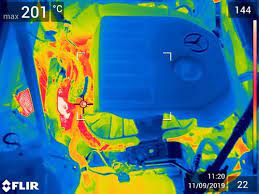
When visibility on the road is compromised by low light, a group of unrelated technologies together referred to as Automotive Night Vision. It can aid to improve situational awareness.
To expand the driver’s field of vision beyond what headlights can see, these systems employ thermographic cameras, infrared lights, and heads-up displays. Automotive night vision has the potential to reduce accidents by warning drivers of otherwise undetectable dangers.
What Does Automotive Night Vision Mean for Automobiles?
Passive Night Vision
1. Detects thermal radiation using thermographic cameras
2. Excellent for exposing “thermal” objects like vehicles, animals, people, and more
Active Night Vision
1.Uses infrared light to make the dark visible
2. Reveals objects that are visible only at a great distance from the headlights
Automotive night vision comes in two varieties: passive and active. Thermal cameras are used by passive systems to illuminate the heat emitted by people, animals, and objects. Darkness is illuminated by active systems using infrared light sources.
The infrared light spectrum, which is invisible to the human eye, provides the basis for both active and passive night vision devices. Each of them has advantages and disadvantages of their own.

Passive Night Vision Pros and Cons
| Pros | Cons |
| 1. Effective at exposing individuals, pets, and other automobiles | Reveals inanimate items like rocks or fences fairly poorly |
| 2. greater visible range than night vision that is active | Less efficient when it’s warm outside |
Thermographic cameras are used by passive night vision systems to identify thermal radiation. It is simple for thermographic cameras to distinguish between a warm item, like a human, and a cooler object, like a road, because they can “see” heat.
Passive systems analyze data from thermal cameras to create a black-and-white image that gives the driver a better perspective of the road. Passive systems typically operate very well with people, animals, and other vehicles since they all emit large amounts of thermal radiation due to the dependence on heat emissions. The disadvantage of passive systems is that they have difficulty detecting inanimate items that are close to the ambient temperature.
Passive night vision often has a wider field of view than active night vision. This is because active systems’ light sources only have a certain amount of power. In contrast to active systems, thermographic cameras typically produce images of poor quality. Additionally, they are less effective in hot climates because elevated air temperatures naturally cause typically cool materials, such as road surfaces, to warm up throughout the day and radiate heat at night.
Active Night Vision Pros and Cons
| Pros | Cons |
| 1. Generally superior image quality to passive night vision | Does not perform well in bad weather, such as snow and hail |
| 2. Can shine light on distant objects that headlights cannot |
Because they make use of infrared light sources, active systems are more complicated than passive ones. These light sources do not give incoming drivers temporary night blindness like high beam headlights do since the infrared band is outside of the visible spectrum. As a result, objects that are much further away than the range of headlights can be illuminated by infrared lights.
Active night vision systems require specialized cameras to provide the additional visual data because infrared light is invisible to the human eye. While some systems employ a steady light source, others use pulsed infrared lights. Due to the possibility of the infrared light source being partially blocked by inclement weather, such as heavy snow or hail, these systems perform poorly under those situations. Active systems, on the other hand, may deliver sharp images of automobiles, animals, and even inanimate things.
How Does Thermographic or Infrared Information Aid Your Vision?


The driver can get infrared or thermographic information via night vision displays in a number of ways. Early night vision devices featured heads-up displays, which projected alerts and warnings onto the windshield in the driver’s range of vision. Other systems employ a head unit, instrument cluster, or dash-mounted LCD.
Which Vehicles Are Equipped With?
Even though automotive night vision systems have been around since 1988, only expensive cars tend to have them. The technology can be very expensive and is typically optional. GM introduced the first night vision systems, but today several other automakers have their own iterations of the technology.
Active systems are available from Toyota, Lexus-badged Toyota, and Mercedes. Passive options are provided by other automakers, including Audi, BMW, and Honda. A passive night vision system was also available on Cadillac models from General Motors, however it was removed from the lineup in 2004. A variety of aftermarket systems are also offered.
Conclusion: Can night vision prevent accidents?
Nearly half of all accidents, according to the European Commission for the Automobile Industry, take place at night. It is evident that a disproportionately high number of accidents take place between dark and morning because the same survey revealed that traffic is around 60% less throughout the night.
There isn’t enough data to tell with certainty whether or not night vision systems are helpful because it’s not commonplace. The National Highway Transportation Safety Administration conducted a study that found some drivers are inclined to drive more quickly at night when using these devices, which could increase the number of accidents.
However, there are various technologies that improve sight at night can lower accidents. It’s possible that widespread use of night vision may have similar impacts, given how innovations like adaptive headlights have reduced the number of accidents that occur at night.
Traditional headlights normally only highlight items that are roughly 180 feet away, but night vision systems can identify objects that are more than 500 feet away. Given that a car’s stopping distance can easily exceed 180 feet, it is obvious that a careful driver can avoid collisions with the right usage of a night vision equipment.
Frequently Asked Questions
1. Has a Rolls Royce night vision system?
One of the rare cars with night vision is the Rolls-Royce Wraith, which is also the only one I know of with it as a standard feature. The pedestrian warning feature of the 2018 Wraith’s night-vision system to be quite useful while operating the vehicle in the Pacific Northwest on gloomy winter nights. Yeah! It’s night vision system is outstanding.
2. Can we see at night amid fog?
Dusty, foggy, or smoky circumstances will prevent night vision cameras from functioning. smoke, fog, or dust will hide the image. In short, night vision cameras only function when you’re driving on a route without many obstructions and on clear nights with some moonlight. Your night vision camera is essentially worthless if you are not in the “Habitable zone.”
3. What kind of sensing technology are there in night vision?
These gadgets use digital CCD (charge-coupled devices) or SMOS (complimentary metal-oxide semiconductor) sensors. Just like your digital camera, as suggested by the name. Digital night vision devices use CCD and CMOS sensors. Because of their sensitivities in the near infrared band, which is up to 1.1 m.



